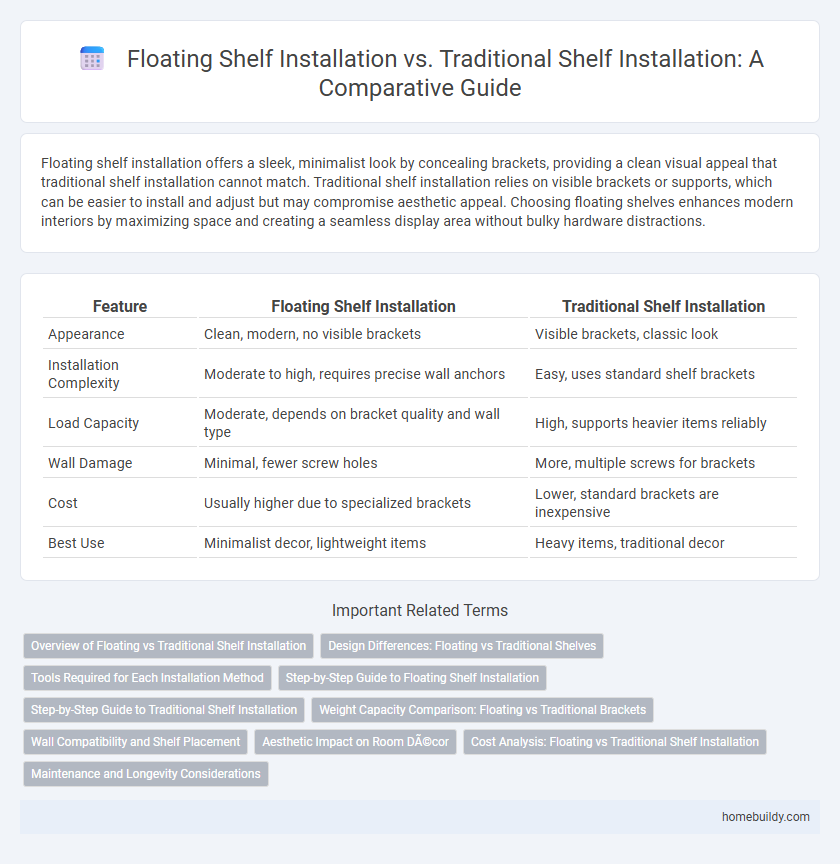Floating shelf installation offers a sleek, minimalist look by concealing brackets, providing a clean visual appeal that traditional shelf installation cannot match. Traditional shelf installation relies on visible brackets or supports, which can be easier to install and adjust but may compromise aesthetic appeal. Choosing floating shelves enhances modern interiors by maximizing space and creating a seamless display area without bulky hardware distractions.
Table of Comparison
| Feature | Floating Shelf Installation | Traditional Shelf Installation |
|---|---|---|
| Appearance | Clean, modern, no visible brackets | Visible brackets, classic look |
| Installation Complexity | Moderate to high, requires precise wall anchors | Easy, uses standard shelf brackets |
| Load Capacity | Moderate, depends on bracket quality and wall type | High, supports heavier items reliably |
| Wall Damage | Minimal, fewer screw holes | More, multiple screws for brackets |
| Cost | Usually higher due to specialized brackets | Lower, standard brackets are inexpensive |
| Best Use | Minimalist decor, lightweight items | Heavy items, traditional decor |
Overview of Floating vs Traditional Shelf Installation
Floating shelf installation involves mounting brackets hidden within the shelf, creating a sleek, modern look without visible supports. Traditional shelf installation uses external brackets or corbels, offering easier load capacity adjustments and simpler installation steps. Choosing between floating and traditional shelving depends on aesthetic preferences, weight requirements, and wall type compatibility.
Design Differences: Floating vs Traditional Shelves
Floating shelf installation features concealed brackets that provide a sleek, modern aesthetic by hiding all support mechanisms within the wall, creating the illusion that the shelf is suspended without hardware. Traditional shelf installation uses visible brackets or corbels that attach underneath or on the sides, offering a more classic and sturdy design with exposed support elements. These design differences impact both the visual appeal and the overall space utilization, with floating shelves promoting minimalism and traditional shelves emphasizing structural presence.
Tools Required for Each Installation Method
Floating shelf installation typically requires a power drill, stud finder, level, screwdriver, and anchors or mounting brackets specifically designed for hidden supports. Traditional shelf installation often involves a drill or screwdriver, brackets or corbels, wall anchors, and a level for alignment. Both methods demand precise measurements and appropriate hardware to ensure stability, but floating shelves may necessitate more specialized tools for concealed mounting systems.
Step-by-Step Guide to Floating Shelf Installation
Floating shelf installation requires precise measurement and securing concealed brackets into wall studs for optimal support and stability. Start by marking the bracket positions on the wall, drilling holes carefully, and anchoring the brackets firmly before sliding the shelf onto the mounted supports. This method offers a sleek, modern look compared to traditional shelf installation, which typically uses visible brackets and requires mounting directly beneath the shelf for support.
Step-by-Step Guide to Traditional Shelf Installation
Traditional shelf installation involves securely attaching brackets to the wall studs using screws, ensuring strong support for heavy loads. First, mark the desired shelf height, locate studs with a stud finder, and drill pilot holes for the brackets. Finally, mount the brackets firmly and place the shelf on top, fastening it to the brackets for stability and durability.
Weight Capacity Comparison: Floating vs Traditional Brackets
Floating shelf brackets typically support between 20 to 40 pounds depending on wall type and bracket quality, while traditional shelf brackets can hold significantly more weight, often exceeding 75 pounds. The design of traditional brackets distributes load across the wall and bracket arms, providing enhanced stability for heavier items. Choosing between floating and traditional shelf brackets depends on the weight requirements of the intended shelf use, with traditional brackets favored for heavy-duty storage needs.
Wall Compatibility and Shelf Placement
Floating shelf installation offers superior wall compatibility by using concealed brackets that anchor directly into wall studs, allowing for seamless integration on drywall or plaster surfaces without visible supports. Traditional shelf installation requires external brackets or supports that must be mounted on studs or anchors, limiting placement options and sometimes compromising aesthetic appeal. Floating shelves enable more flexible shelf placement across various wall types while maintaining a clean, minimalist look ideal for modern interiors.
Aesthetic Impact on Room Décor
Floating shelf installation enhances room decor by providing a sleek, minimalist look with concealed supports that create an illusion of shelves seamlessly emerging from the wall. Traditional shelf installation, featuring visible brackets and hardware, offers a more classic and robust aesthetic but can interrupt the visual flow of the room. The choice between floating and traditional shelves significantly influences the overall style, with floating shelves favoring modern, clean lines and traditional brackets adding decorative or industrial character.
Cost Analysis: Floating vs Traditional Shelf Installation
Floating shelf installation typically incurs higher costs due to the need for specialized brackets and precise wall anchoring, often ranging from $50 to $150 per bracket. Traditional shelf installation uses standard brackets or supports, generally costing between $10 and $40 each, making it more budget-friendly. Labor expenses for floating shelves can also increase due to the complexity of alignment, whereas traditional shelves involve quicker, simpler mounting processes.
Maintenance and Longevity Considerations
Floating shelf installation offers a sleek design with concealed supports, reducing dust accumulation and simplifying cleaning compared to traditional shelf brackets that are exposed and more prone to wear. Maintenance for floating shelves typically involves checking internal anchors to ensure stability, while traditional shelves may require tightening visible screws and brackets over time. Longevity of floating shelves depends largely on proper installation and weight limits, whereas traditional shelves often provide greater load-bearing capacity but may experience faster hardware degradation due to environmental exposure.
Floating shelf installation vs Traditional shelf installation Infographic

 homebuildy.com
homebuildy.com